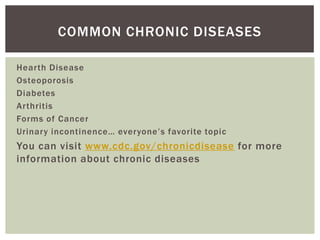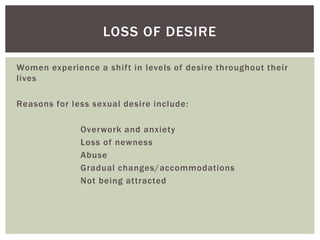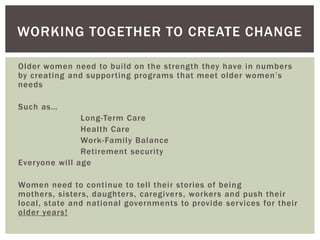Teachback womens health
- 1. OUR LATER YEARS CHAPTER Aspects of aging that affect our… Health S o c i a l E m ot i o n a l We l l b e i n g Re p r o d u c t i v e H e a l t h a n d S e x u a l i t y “Our we as old as we look or as old as we feel”
- 2. QUESTIONS FOR THOUGHT??? 1. How can we make the adaption needed to maximize good health and maintain Independence and Quality of Life? 2. How much medical intervention are we comfortable with in our later years? ( 60-80 yrs.) Breast Exams Vaginal Exams Preventative Health 3. How does sex and sexual pleasures fit into our lives in our later years?
- 3. THE NEW OLD AGE Aging has become feminized Women live longer Fitness becomes a problem as we age 65 and older 12% live in poverty Our bodies in context Most cultures value and honor older people *In the United States they idealize the young and discriminate against older adults.
- 4. ADVERTISEMENTS Advertisements play on and exaggerate a women’s fear and anxieties about the natural changes in their body as they age Pharmaceutical – Hormone replacement & cologin Plastic Surgery – Botox & Laser Treatment Cosmetics – Oil of Olay & Clinique “ Self acceptance as we age can be hard won but…invaluable” pg 550
- 5. RELATIONSHIPS Maintaining Connections Set new goals as relationships change Evaluate or assess our love and relationships Change in gestational hierarchy in family No matter how we define relationships, social connections have positive effect on ones health Dealing with Loss During our older years we experience the death of more friends and loved ones
- 6. GOING AT IT ALONE 65 and older – 42% of women are widowed 65 and older – 14% of men are widowed 65 and older – 45% of women live alone 65 and older – 19% of men live alone
- 7. AGING AND HEALTH We all age dif ferently some women have developed disabilities from an early age More women develop disabilities in midlife or older
- 8. PREVENTIVE MEASURES: TAKING CARE OF OURSELVES The key word is prevention Prevention is doing what we can to take care of ourselves so as to avoid or ease the chronic conditions associated with later life Healthy habits include no nicotine and excessive alcohol and as much exercise and nutritious eating as possible.
- 9. PREVENTIVE MEASURES: TAKING CARE OF OURSELVES CONTINUED There are many factors beyond our control such as… Occupational Health Hazard High Blood Pressure Diabetes Ethnicity “Strive to make changes that are within out power”
- 10. BASIC PREVENTATIVE MEASURES Start and or continue to exercise Engage your mind Get to bed – you need sleep just like young adults Schedule checkups which can now be paid for by the 2010 health care reform act
- 11. COMMON CHRONIC DISEASES Hearth Disease Osteoporosis Diabetes Arthritis Forms of Cancer Urinary incontinence… everyone’s favorite topic You can visit www.cdc.gov/chronicdisease for more information about chronic diseases
- 12. GUIDELINES FOR SEXUAL AND REPRODUCTIVE HEALTH CARE By the age of 60 a women has undergone regular screenings for Cervical Cancer or Breast Cancer Longevity is a recent phenomenon in women so… There is not a lot of data on screening for women over 85. It is important to maintain Vaginal Health Mamograms – every year for women age 50-74 Pap screenings – 65 and older should discuss with their health care provider Bone screenings should be done at 65 and every 2 years following
- 13. SEXUALIT Y The Sex Continuum Our society views older women as “drugged up” and sexless. Sexuality unlike, fertility, can continue throughout your life Many women enjoy sex more in the middle and later stages of their lives due to appreciating their body and sexuality more fully Adjustments, disruptions or feeling less sexual can also result from chronic or acute illness or surgery
- 14. PHYSICAL CHANGES THAT AFFECT SEXUALIT Y 2 01 0 H a r v a r d M e d i c a l S c h o o l S p e c i a l H e a l t h Re p o r t S ex u a l i t y i n M i d l i fe a n d B eyo n d Po s s i b l e A g e Re l a te d S ex u a l C h a n g e s f o r Wo m e n : P hy s i c a l C h a n g e s : Low estrogen Decreased blood flow to genitals Thinning of vaginal lining Muscle tone Desire – Decreased libido, fewer sexual thoughts Arousal – Reduced vaginal lubricants, less blood and congestion Orgasm – Delayed or absent Resolution – body returns rapidly to a non - aroused state “Only 22% of women discuss sex with a physician af ter 50”
- 15. PRACTICAL APPROACH TO AGE RELATED SEXUAL CHANGES Declining Health Body Changes Chronic Illness Medication Health Benefits to Sexual Activity Expand Energy Burns Calories – Brain release endorphins Reduced Stress Sleep Better Delay or minimize incontinence by working pelvis Delay Pain – Orgasm can reduce pain
- 16. LOSS OF DESIRE Women experience a shift in levels of desire throughout their lives Reasons for less sexual desire include: Overwork and anxiety Loss of newness Abuse Gradual changes/accommodations Not being attracted
- 17. PLEASURING OTHERS AND YOURSELF Viagra and other erectile dysfunction medications exist for men Navigating Health Care In the twenty -first century medical care there is a great shortage of doctors, nurses, psychologists, psychiatrists, dentists and other health care professionals trained in caring for older adults
- 18. THE INSTITUTE OF MEDICINE Predictions in the near future… 2007 = 1 geriatrician for every 2,546 older adults 2030 = 1 geriatrician for every 4,254 older adults 2007 = 1 geriatric psychiatrist for every 11,372 older adults 2030 = 1 geriatric psychiatrist for every 20,195 older adults
- 19. WRONG DIAGNOSIS, WRONG TREATMENT Providers without adequate training may treat older women inaccurately They may not fully treat chronic illness Misdiagnosis or fail to manage reversible conditions Over proscribe medications People over the age of 65 take 34% of medications Prescriptions are based on a yearly basis in the US They are only 13% of the US population
- 20. PLANNING AHEAD Be proactive … Plan Ahead Look into retirement Health Care Long-term Care Housing Activities Your Community Can Help
- 21. PLANNING AHEAD CONTINUED Retirement and Social Security Planning ahead is critical in dealing with gaps in your earning during employment years Raising children Taking care of older parents Housing As you get older you may… Move to a smaller home Get a roommate Moving to a retirement home Receive elder services in your own house
- 22. MORE PLANNING AHEAD Household help and Long Term Care Long term care services are very expensive Community Living Assistance Services and Support Act (Class Act) 2010 Health Reform Law Voluntary Long-Term Care insurance program for senior and disabled people to pay no medical services and support Contribute for 5 years – A benefit on average of $50 a day
- 23. HEALTH AND LEGAL DECISION Power of Attorney – A trusting person has the authority to act on your behalf in financial and legal matters if unable to take action yourself Health Care Proxy Document – A person you trust authority to make medical testing and treatment decisions Medical Advance Directive or Living Will – Describes the medical treatment one wishes to receive or refuse… and under what conditions
- 24. END OF LIFE CARE Sometimes medical science, not the concern of a women’s life quality, shapes the advice we receive about death and dying Talk to a health care provider about your wishes You need to manage your own healthcare Compassionate end-of-life care that addresses you emotional, spiritual and practical needs is essential, regardless of the type of treatment or care chosen
- 25. CAREGIVER 66% of caregivers are women 41% work full time 13% work part time The economic value of caregivers unpaid contributions is estimated at $375 billion Care givers have high rates of Depression Chronic Diseases Infections Exhaustion This is compared to non-caregivers of the same age
- 26. RESPITE AND RESOURCES Family Caregiver Alliance ( caregive.org) Information services and advocacy for caregivers National Alliance for Caregivers ( caregiving.org) Non-profit coalition of national organizations focused as family caregivers Roselynn Carter Institute of Caregiving ( roselynncarter.org) Established local and state partnerships that build quality long-term and home based services Share the Care (sharethecare.org) creative models in which neighborhoods help families
- 27. ACCEPTING CARE WHEN WE NEED IT Women need to accept help without feeling deminished Helpers need to provide choices when possible Living Full: Building Community, Continuing Advocacy “From the bottom of my heart: Life gets greater and more surprising after 40, 50, 60 and yes 70.” -Gloria Steinem- One must have a sense of purpose and enthusiasm for life
- 28. ACCEPTING CARE WHEN WE NEED IT CONTINUED You need fulfillment during later years Why do you need fulfillment… Less time left Clarified priorities More knowledge of what matters Dr. Gene Cohen, geriatric psychiatrist was convinced older people have untapped wells of creativity and skills “Chocolate for the aging brain”
- 29. INTERGENERATIONAL LIVING Older women’s wisdom and skills are much needed by younger generations We must work toward building a society that celebrates and supports the elderly
- 30. WORKING TOGETHER TO CREATE CHANGE Older women need to build on the strength they have in numbers by creating and supporting programs that meet older women’s needs Such as… Long-Term Care Health Care Work-Family Balance Retirement security Everyone will age Women need to continue to tell their stories of being mothers, sisters, daughters, caregivers, workers and push their local, state and national governments to provide services for their older years!





























